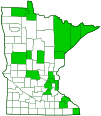bowl-and-doily spider
(Frontinella pyramitela)
Conservation • Description • Habitat • Biology • Distribution • Taxonomy
|
|
||||||||||||||
Description |
Bowl-and-doily spider is a common, small, sheet weaving spider. It occurs throughout North America and Central America, but it is most common in the United States and southern Canada east of the Great Plains and west of the Rocky Mountains. It is found in sphagnum bogs, where it is very common, but also in black spruce/tamarack bogs, pine woodlands, shrubby areas, and areas with tall grasses; at woodland edges; and on shrubs in people’s yards. The female is ⅛″ (3.0 to 4.0 mm) in length and has a ⅜″ to ½″ (9 to 12 mm) legspan. The front part of the body (cephalothorax) is egg-shaped when viewed from above and flat when viewed from the side. There are eight eyes arranged in two parallel rows of four eyes each. All of the eyes are about the same size. The back (posterior) row is distinctly curved, the front (anterior) row is nearly straight. In the posterior row the middle (median) eyes (PME) are slightly closer to each other than they are to the outer (lateral) eyes (PLE). The median ocular area (MOA), the area defined by the middle four eyes, is as wide or only slightly narrower in front than behind. The mouthparts (chelicerae), corresponding to the jaws, are strong. Each fang rests in a furrow between two ridges (margins). The outer, forward-facing margin (promargin) has five or six teeth. The inner, rearward-facing margin (retromargin), closest to the mouth, has five very small teeth. The exoskeletal plate (carapace) covering the cephalothorax is uniformly dark brown. The plate on the underside of the cephalothorax (sternum) is longer than wide. The abdomen is oblong, longer than wide, and about as high in back as in front. The shape is highly variable, depending on how well fed the spider is and whether it is carrying eggs. It is white with a broad dark brown stripe in the middle. Several dark lines run down each side of the abdomen and usually extend up to the stripe. The underside of the abdomen is dark brown. The legs are long, slender, spiny, and pale yellowish-tan. On the front legs the seventh segment (tarsus) is one half to two-thirds as long as the sixth segment (metatarsus). There are three minute claws at the end of the tarsus but these are not visible without magnification. The male is slightly smaller, ⅛″ (3.0 to 3.3 mm) in length. The head is somewhat higher. The chelicerae have two or three promarginal teeth and four or five retromarginal teeth. |
Size |
Female Body Length: ⅛″ (3.0 to 4.0 mm) Male Body Length: ⅛″ (3.0 to 3.3 mm) Legspan: ⅜″ to ½″ (9 to 12 mm) |
Web |
The web typically consists of a “finger-bowl-like” web suspended below a much larger, flat, almost horizontal sheet of irregular, tangled threads. This is the feature that gives the species its common name. The web is built in low branches of trees, in shrubs, and in tall grasses. The spider clings upside down under the center of the bowl. When an insect hits one of the tangled threads, it falls into the bowl. The spider then pulls it through the bottom and carries it to the sheet to consume it. |
Similar Species |
Habitat |
Pine woodlands, woodland edges, shrubby areas, areas with tall grasses, and yards |
Biology |
Season |
|
Behavior |
Females and males are often found using a single web. This is one of just a few spider species in which the male and female share a web. Spiderlings disperse in the fall by “ballooning”. They climb a branch, blade of grass, or fencepost, and release a long thread of silk. The silk thread catches the wind or even a light breeze and the spiderling floats, often a great distance, to a new site. |
Life Cycle |
|
Food |
|
Distribution |
||
|
Sources |
|
| 11/1/2024 | ||
Occurrence |
||
Common |
||
Taxonomy |
|
Class |
Arachnida (arachnids) |
Order |
|
Suborder |
Araneomorphae (typical spiders) |
Infraorder |
Entelegynae |
Superfamily |
Araneoidea (orbweavers and allies) |
Epifamily |
Linyphioidea (dwarf, sheetweb, and hammock-web spiders) |
Family |
Linyphiidae (sheetweb and dwarf spiders) |
Subfamily |
Linyphiinae (sheet-weavers) |
Genus |
Frontinella |
This species was first described in 1841 as Frontinella pyramitela. It was separately described in 1850 as Linyphia communis. It was later determined that they were the same species. Today, most sources use the name Frontinella pyramitela, but some use the name Frontinella communis. |
|
Subordinate Taxa |
|
|
|
Synonyms |
|
Frontinella communis Linyphia communis Linyphia pyramitela |
|
Common Names |
|
bowl and doily weaver bowl-and-doily spider |
|
Glossary
Carapace
The hard, upper (dorsal), shell-like covering (exoskeleton) of the body or at least the thorax of many arthropods and of turtles and tortoises. On crustaceans, it covers the cephalothorax. On spiders, the top of the cephalothorax made from a series of fused sclerites.
Cephalothorax
The front part of the body of various arthropods, composed of the head region and the thoracic area fused together. Eyes, legs, and antennae are attached to this part.
Chelicerae
The pair of stout mouthparts, corresponding to jaws, in arachnids and other arthropods in the subphylum Chelicerata.
Metatarsus
The sixth segment of a spider leg.
Tarsus
On insects, the last two to five subdivisions of the leg, attached to the tibia; the foot. On spiders, the last segment of the leg. Plural: tarsi.
Visitor Photos |
||
Share your photo of this arachnid. |
||
This button not working for you? |
||
Alfredo Colon |
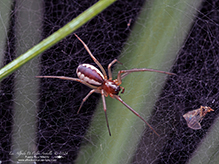 |
Babette Kis |
||
Frontinella pyramitela bowl and doily spider I was looking through your spider species list, and didn't find this dwarf spider listed. BugGuide does have photos from Minnesota. It's a tiny critter, about 2 1/2 mm long, but the webs are often found. |
||
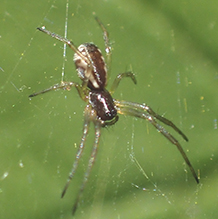 |
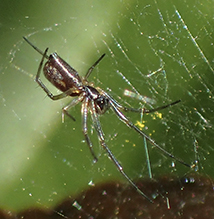 |
|
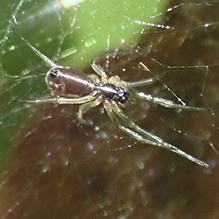 |
|
|
MinnesotaSeasons.com Photos |
||
|
||
|

Slideshows |
|

Visitor Videos |
||
Share your video of this arachnid. |
||
This button not working for you? |
||
|
Other Videos |
||
Bowl and Doily Spiders: NARRATED |
About
Oct 20, 2015 Here's a bowl and a doily your grandmother would envy--if she didn't scream. |

Created: 4/24/2023 Last Updated: © MinnesotaSeasons.com. All rights reserved. |
